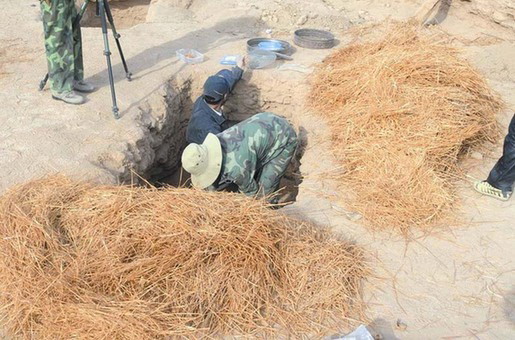Research continues on 2,000-year-old wheat
Updated: 2014-04-02 13:27
By Wang Ru (chinadaily.com.cn)
|
||||||||
 |
|
Wheat plants unearthed from an ancient tomb in Shengjindian, the Xinjiang Uygur autonomous region.Photo provided to chinadaily.com.cn |
Chinese scientists will continue research on wheat from more than 2,000 years ago discovered in an ancient tomb in the Xinjiang Uygur autonomous region in China.
The wheat, around 3,100 plants, was unearthed in a tomb chamber in Shengjindian, Turpan, in 2010, and will be transferred this month from a local research institution in Turpan to the Department of Scientific History and Archaeometry under the Graduate University of the Chinese Academy of Sciences in Beijing.
Along with the wheat, the Shengjindian tomb revealed a large number of relics from 2200-2050 BC, including artificial limbs and wooden ornaments. Through thorough research, scientists hope to learn more about how the nomadic herders living in the region transferred to an agricultural lifestyle. Wheat was introduced to Xinjiang around 4,000 years ago, but how the wheat was planted and processed remains a mystery.
“The preliminary research result shows that the wheat planting technique in the region then was advanced,” said Li Jingjing,a researcher with the archaeometry department in Beijing. “Compared to today’s wheat, which has 20 to 30 kernels in each plant, every plant of the unearthed wheat has around 10 kernels. For the agricultural techniques of 2,000 years ago, that was a remarkable achievement. “It also suggests the herders then started to spend more time on large-scale planting than hunting, and to learn to use the earliest farming tools,” Li said.

 Gorgeous Liu Tao poses for COSMO magazine
Gorgeous Liu Tao poses for COSMO magazine
 Post-baby Duchess
Post-baby Duchess
 Victoria Beckham S/S 2014 presented during NYFW
Victoria Beckham S/S 2014 presented during NYFW
 'Despicable' minions upset Depp's 'Lone Ranger' at box office
'Despicable' minions upset Depp's 'Lone Ranger' at box office
 'Taken 2' grabs movie box office crown
'Taken 2' grabs movie box office crown
 Rihanna's 'Diamonds' tops UK pop chart
Rihanna's 'Diamonds' tops UK pop chart
 Fans get look at vintage Rolling Stones
Fans get look at vintage Rolling Stones
 Celebrities attend Power of Women event
Celebrities attend Power of Women event
Most Viewed
Editor's Picks

|

|

|

|

|

|
Today's Top News
5 dead in magnitude 8.2 quake off Chile
MH370 'unlikely' to hurt ties
Xi's trip builds bridge to Europe
Weibo to list on Nasdaq
Beijing must help win the global battle on climate
Remembering a true hero of WWII
Drone falls in ROK island
We should join hands, Xi tells EU
US Weekly

|

|







